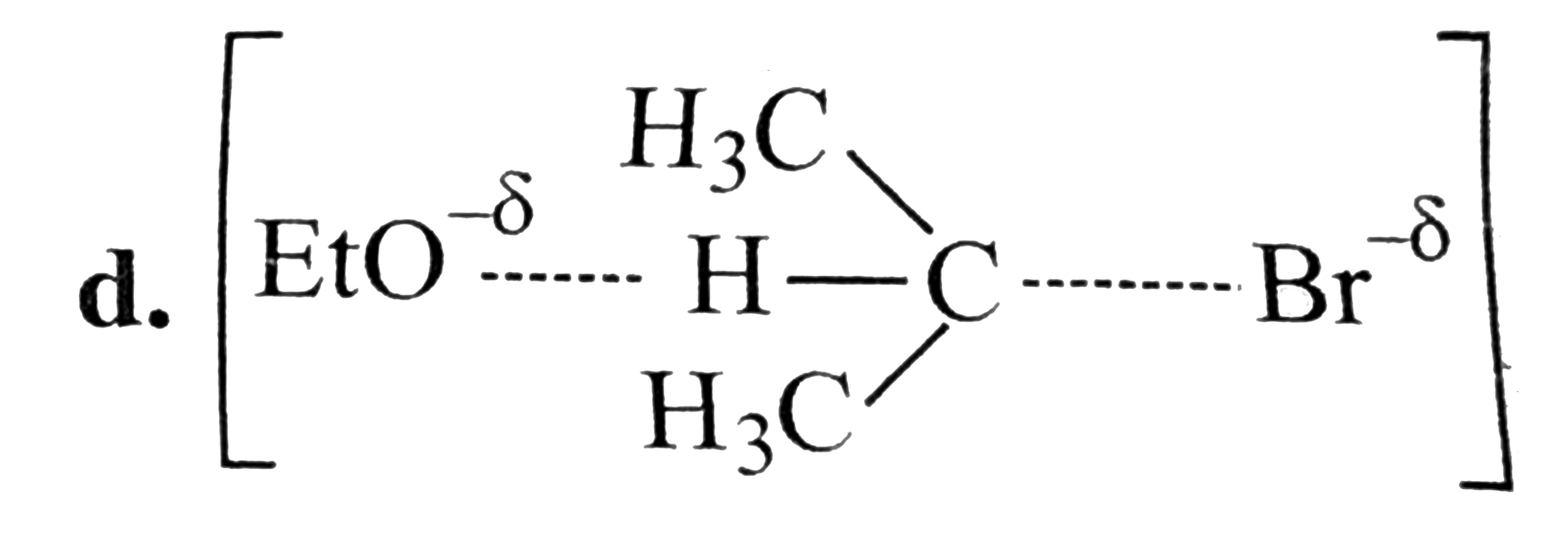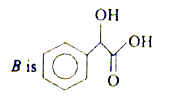IsoprophI bromide was treated separately with sodium ethoxide under two different conditions.
Reaction I:
Treatment of isopropyI bromide with (Me3CONa) at 40∘C gave almost exclusively compound (A)(C3H6).
Reaction II:
Treatment of (i−PrBr) with NaOC2H5 at 30∘C yileled compound (A)(C3H6) along with a small amount of an ether (B)(C5H12O).
Compound (A) was readily oxidised by a neutral solution of cold dil. KMnO4 to give a brown preciptate.
Referring to Q. No. 67 which of the following represents the intermediate T.S for the formation of compound (B) ?




The correct Answer is:c
To solve the problem, we need to analyze the reactions of isopropyl bromide with sodium ethoxide under two different conditions and identify the transition state for the formation of compound B.
Step 1: Understand the Reactants and Products
- Isopropyl bromide (i-PrBr) has the structure:
(CH3)2CHOBr
- When treated with sodium ethoxide (NaOC₂H₅), it can yield compound A (C₃H₆) and compound B (C₅H₁₂O).
Step 2: Analyze Reaction I
- In Reaction I, isopropyl bromide is treated with (Me₃CONa) at 40°C, leading to the formation of compound A. This suggests a straightforward substitution reaction, likely an SN2 mechanism, where the bromine leaves and a nucleophile replaces it.
Step 3: Analyze Reaction II
- In Reaction II, isopropyl bromide is treated with NaOC₂H₅ at 30°C. This reaction yields compound A along with a small amount of ether (compound B). The ether formation indicates that there is an additional step occurring here.
Step 4: Identify the Mechanism
- The formation of compound B (an ether) suggests that the reaction involves an SN2 mechanism where the ethoxide ion (C₂H₅O⁻) attacks the isopropyl bromide. The bromine atom acts as a leaving group.
Step 5: Draw the Transition State
- In the transition state, the nucleophile (C₂H₅O⁻) is attacking the carbon atom that is bonded to the bromine. The bromine is partially leaving, resulting in a high-energy state.
- The structure of the transition state can be represented as:
C(CH3)2C(O−C2H5)(Br)(partial bond)
- In this state, the carbon is bonded to both the ethoxide and the bromine, which is about to leave.
Step 6: Identify the Correct Option
- Based on the structure of the transition state, we can conclude that option C represents the correct transition state for the formation of compound B.
Final Answer:
The transition state for the formation of compound B is represented by option C.
---
- Isopropyl bromide (i-PrBr) has the structure:
(CH3)2CHOBr
- When treated with sodium ethoxide (NaOC₂H₅), it can yield compound A (C₃H₆) and compound B (C₅H₁₂O).
- In Reaction I, isopropyl bromide is treated with (Me₃CONa) at 40°C, leading to the formation of compound A. This suggests a straightforward substitution reaction, likely an SN2 mechanism, where the bromine leaves and a nucleophile replaces it.
- In Reaction II, isopropyl bromide is treated with NaOC₂H₅ at 30°C. This reaction yields compound A along with a small amount of ether (compound B). The ether formation indicates that there is an additional step occurring here.
- The formation of compound B (an ether) suggests that the reaction involves an SN2 mechanism where the ethoxide ion (C₂H₅O⁻) attacks the isopropyl bromide. The bromine atom acts as a leaving group.
- In the transition state, the nucleophile (C₂H₅O⁻) is attacking the carbon atom that is bonded to the bromine. The bromine is partially leaving, resulting in a high-energy state.
- The structure of the transition state can be represented as:
C(CH3)2C(O−C2H5)(Br)(partial bond)
- In this state, the carbon is bonded to both the ethoxide and the bromine, which is about to leave.
- Based on the structure of the transition state, we can conclude that option C represents the correct transition state for the formation of compound B.
The transition state for the formation of compound B is represented by option C.
Topper's Solved these Questions
- AROMATIC COMPOUNDS AND ALKYL AND ARYL HALIDES BOOK - CENGAGE CHEMISTRY ENGLISHCHAPTER - AROMATIC COMPOUNDS AND ALKYL AND ARYL HALIDES EXERCISE - Exercises Linked Compreshension Type
11 Videos
- AROMATIC COMPOUNDS AND ALKYL AND ARYL HALIDES BOOK - CENGAGE CHEMISTRY ENGLISHCHAPTER - AROMATIC COMPOUNDS AND ALKYL AND ARYL HALIDES EXERCISE - Exercises Multiple Correct
32 Videos
- AROMATIC COMPOUNDS AND ALKYL AND ARYL HALIDES BOOK - CENGAGE CHEMISTRY ENGLISHCHAPTER - AROMATIC COMPOUNDS AND ALKYL AND ARYL HALIDES EXERCISE - Exercises Concept Application
4 Videos
- APPENDIX INORGANIC VOLUME 2BOOK - CENGAGE CHEMISTRY ENGLISHCHAPTER - APPENDIX INORGANIC VOLUME 2EXERCISE - Short Answer Type
179 Videos
- BIOMOLECULESBOOK - CENGAGE CHEMISTRY ENGLISHCHAPTER - BIOMOLECULESEXERCISE - Exercises Archives (Analytical And Descriptive)
8 Videos
Similar Questions
IsoprophI bromide was treated separately with sodium ethoxide under two different conditions.
Reaction I:
Treatment of isopropyI bromide with (Me3CONa) at 40∘C gave almost exclusively compound (A)(C3H6).
Reaction II:
Treatment of (i−PrBr) with NaOC2H5 at 30∘C yileled compound (A)(C3H6) along with a small amount of an ether (B)(C5H12O).
Compound (A) was readily oxidised by a neutral solution of cold dil. KMnO4 to give a brown preciptate.
The formations of (A) and (B) are best explained by:
View SolutionIsoprophI bromide was treated separately with sodium ethoxide under two different conditions.
Reaction I:
Treatment of isopropyI bromide with (Me3CONa) at 40∘C gave almost exclusively compound (A)(C3H6).
Reaction II:
Treatment of (i−PrBr) with NaOC2H5 at 30∘C yileled compound (A)(C3H6) along with a small amount of an ether (B)(C5H12O).
Compound (A) was readily oxidised by a neutral solution of cold dil. KMnO4 to give a brown preciptate.
Which of the following is an accurate representations of compound (B) ?
View Solution
Knowledge Check
Compound 'A' with the formula C3H8O on vigorous oxidation produces an acid C3H6O2. 'A' is
Aa tertiary alcoholBa secondary alcoholCa primary alcoholDnot necessarily an alcoholCompound (A) C8H6O2 on treatment with aq. NaOH followed by acidification gives (B) C3H2O3 which on oxidation gives benzoic acid only:
A B
B C
C D
D
A compound 'A' (C7H8O) is insoluble in water, dilute Hcland aqueous NaHCO3 but soluble in dilute NaOH. When Ais treated with Br2−H2O, it is converted into a compound of formula C7H5Obr3. Compound A is :
A B
B C
C D
D
IsoprophI bromide was treated separately with sodium ethoxide under two different conditions.
Reaction I:
Treatment of isopropyI bromide with (Me3CONa) at 40∘C gave almost exclusively compound (A)(C3H6).
Reaction II:
Treatment of (i−PrBr) with NaOC2H5 at 30∘C yileled compound (A)(C3H6) along with a small amount of an ether (B)(C5H12O).
Compound (A) was readily oxidised by a neutral solution of cold dil. KMnO4 to give a brown preciptate.
Which of the following most accureately repreasents the activated complex formed in reaction (II) that leads to compound (A) ?
View SolutionAn optically active compound H(C5H6O) on treatment with H2 in the presence of Lindlar's catalyst gave a compound I (C5H8O). Upon hydrogenation with H2 and Pd/C, Compound H gave J (C5H12O). Both I and J were found to b optically inactive. Select the correct statements.
View SolutionOptically active isomer (A) of (C5H9Cl) on treatment with one mole of H2 gives an optically inactive compound (B) compound (A) will be :
View SolutionCompound (A) C5H8O2 liberated CO2 on reaction with sodium bicarbonate. It exists in two forms neither of which is optically active. It yielded compound (B) C5H10O2 on hydrogenation. Compound (B) can be separated into enantiomorphs. Write structures of (A) and (B).
View SolutionA compound X of formula C3H8O yields a compound C3H6O, on oxidation. To which of the following classes of compounds could X being
View Solution
